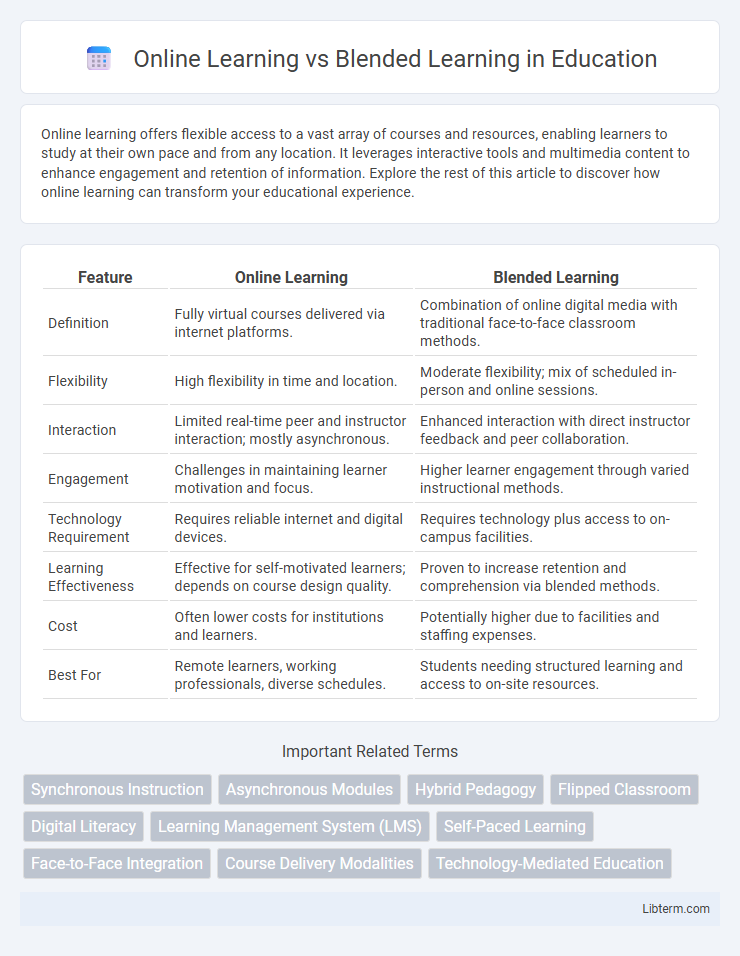Online learning offers flexible access to a vast array of courses and resources, enabling learners to study at their own pace and from any location. It leverages interactive tools and multimedia content to enhance engagement and retention of information. Explore the rest of this article to discover how online learning can transform your educational experience.
Table of Comparison
| Feature | Online Learning | Blended Learning |
|---|---|---|
| Definition | Fully virtual courses delivered via internet platforms. | Combination of online digital media with traditional face-to-face classroom methods. |
| Flexibility | High flexibility in time and location. | Moderate flexibility; mix of scheduled in-person and online sessions. |
| Interaction | Limited real-time peer and instructor interaction; mostly asynchronous. | Enhanced interaction with direct instructor feedback and peer collaboration. |
| Engagement | Challenges in maintaining learner motivation and focus. | Higher learner engagement through varied instructional methods. |
| Technology Requirement | Requires reliable internet and digital devices. | Requires technology plus access to on-campus facilities. |
| Learning Effectiveness | Effective for self-motivated learners; depends on course design quality. | Proven to increase retention and comprehension via blended methods. |
| Cost | Often lower costs for institutions and learners. | Potentially higher due to facilities and staffing expenses. |
| Best For | Remote learners, working professionals, diverse schedules. | Students needing structured learning and access to on-site resources. |
Introduction to Online and Blended Learning
Online learning offers flexible, remote access to educational content through digital platforms, enabling students to engage with coursework anytime and anywhere. Blended learning combines traditional face-to-face instruction with online components, creating a hybrid approach that enhances interaction and personalized learning. Both methods leverage technology to improve accessibility, student engagement, and educational outcomes across diverse learning environments.
Defining Online Learning: Key Features
Online learning is characterized by the delivery of educational content primarily through digital platforms, allowing learners to access materials anytime and anywhere with internet connectivity. Key features include asynchronous access to recorded lectures, interactive multimedia resources, and virtual assessment tools that facilitate self-paced study and instant feedback. This modality emphasizes flexibility, scalability, and the integration of learning management systems (LMS) to track progress and foster remote collaboration.
Understanding Blended Learning: Core Components
Blended learning integrates face-to-face classroom instruction with online digital media, creating a flexible and personalized educational experience. Core components include in-person engagement, online content delivery, and interactive assessments that enhance student participation and understanding. This hybrid model leverages technology to optimize learning outcomes by combining the strengths of both traditional and digital methods.
Flexibility and Accessibility Compared
Online learning offers greater flexibility by allowing students to access course materials and participate in lessons anytime and anywhere, accommodating diverse schedules and learning paces. Blended learning combines face-to-face instruction with online components, providing structured in-person interaction alongside the convenience of digital resources, enhancing accessibility for those who benefit from direct support. Both models improve educational access, but online learning maximizes scheduling freedom while blended learning balances flexibility with personal engagement.
Student Engagement in Online vs Blended Environments
Student engagement in online learning often relies on interactive tools such as discussion forums, video conferencing, and multimedia resources to foster participation. Blended learning environments combine face-to-face interaction with digital activities, enhancing engagement through real-time feedback and collaborative projects. Research indicates that blended learning typically results in higher student motivation and deeper understanding by integrating diverse instructional methods.
Technology Requirements and Challenges
Online learning requires reliable high-speed internet and compatible devices such as laptops or tablets to access virtual classrooms and digital resources, while blended learning combines these digital tools with traditional face-to-face settings, necessitating technology integration in physical classrooms. Challenges for online learning include managing technical issues, ensuring cybersecurity and data privacy, and addressing digital divide concerns among students with limited access. Blended learning demands effective coordination between in-person and online components, requiring educators to be proficient with diverse technology platforms and adaptable to hybrid teaching environments.
Instructor Roles and Teaching Strategies
In online learning, instructors primarily act as content facilitators and technical guides, utilizing digital tools to deliver lectures, provide feedback, and manage virtual discussions. Blended learning requires instructors to skillfully balance face-to-face interaction with online components, employing diverse teaching strategies such as flipped classrooms, collaborative projects, and personalized instruction to enhance student engagement. Effective roles include designing interactive materials, monitoring progress through learning management systems, and adapting methods to meet diverse learner needs in both environments.
Assessment Methods and Learning Outcomes
Online learning utilizes digital assessments such as quizzes, interactive simulations, and automated grading systems to provide immediate feedback and track progress efficiently. Blended learning integrates traditional face-to-face evaluations with online tools, enabling a more comprehensive assessment of critical thinking and practical skills. Studies indicate blended learning often leads to improved learning outcomes due to personalized feedback and diverse assessment formats enhancing student engagement and understanding.
Pros and Cons of Online and Blended Learning
Online learning offers flexibility and accessibility by enabling students to access materials anytime and anywhere, yet it may lead to decreased social interaction and limited hands-on experiences. Blended learning combines online digital media with traditional face-to-face instruction, enhancing engagement and providing immediate feedback, but it requires effective time management and access to both physical and digital resources. Both methods demand self-discipline, with online learning hinging on technology reliability while blended learning benefits from a structured environment balancing virtual and in-person activities.
Choosing the Right Approach: Factors to Consider
When choosing between online learning and blended learning, factors such as student engagement, access to technology, and learning objectives play a crucial role in determining the most effective approach. Blended learning offers a balance of face-to-face interaction and digital content, supporting diverse learning styles and fostering collaboration. Online learning provides flexibility and accessibility, ideal for self-paced study and remote learners requiring adaptable schedules.
Online Learning Infographic

 libterm.com
libterm.com